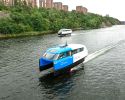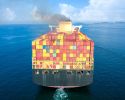Lack of knowledge slows the development of archipelago ports

Municipalities have poor awareness of the international and national regulations that apply to their ports. As a result, there is barely any progress toward more sustainable archipelago ports. This is shown by a new pre-study from Lighthouse and the Swedish Transport Administration.
The demand for environmentally, socially, and economically sustainable sea transport in the archipelago is increasing. Local and regional authorities must therefore modernize their infrastructure to comply with stricter regulations, reduce emissions, and make ports more accessible. But the development faces major challenges.
“Our results show that knowledge of EU regulations and Swedish laws and rules applicable to the development of archipelago ports is very poor within municipal and regional operations. Seven out of ten respondents have not even heard of these rules,” says Henrik Ringsberg of Chalmers, author of the pre-study Sustainable development of archipelagic port infrastructures.
In addition to a structural review of scientific studies and the regulatory framework surrounding port development in Sweden, the project also included a case study involving two regions, four municipalities, and six port authorities. In semi-structured group interviews, local actors were asked to share their view of the level of knowledge regarding applicable regulations—and what obstacles they see in developing more sustainable port infrastructures.
“Since there is no awareness of the laws and regulations and what must be done, this is not included in the municipal comprehensive plans, which span 20 years. As these are linked to the municipal budget, nothing happens, of course. It becomes a bit of an ostrich approach, and the archipelago ports fall between the cracks.”
Another major challenge, according to the report, is that funding for the development of archipelago ports is fragmented.
“There are no regional or municipal funds available for a municipality or region that decides to develop a port. Instead, they have to apply for project funding from, for example, the Swedish Energy Agency to carry out targeted measures. And when that money runs out, they often end up with a facility that cannot be used. Or they have completed a feasibility study but have no money left for the implementation phase. There are plenty of such examples,” says Henrik Ringsberg.
A third finding of the report is that there is no communication between regions on these issues.
“In Västra Götaland County, for example, an energy hub can be established without anyone in Värmland—or even in Fyrbodal—having any knowledge of it. This undermines the possibility of coordination and shared use of energy hubs. It also becomes an economic issue: instead of thinking, ‘if you build an energy hub, we can build a hydrogen hub,’ there is a risk of very costly duplication of work,” says Henrik Ringsberg, and continues:
“Communication between the region and the municipality is also limited. They have meetings, but our results show that no one is satisfied with what comes out of them.”
The next step for Henrik Ringsberg and his colleagues is to seek additional funding to continue working on the issue in a project that will also involve inland ports, as well as Region Gotland—due to the island’s strategic position as a military protection zone.
The pre-study Sustainable development of archipelagic port infrastructures was conducted within the Swedish Transport Administration’s industry program Sustainable Shipping, coordinated by Lighthouse. It was authored by Henrik Ringsberg in collaboration with Chalmers, the University of Gothenburg, Region Stockholm, Region Västra Götaland, Business Region Västra Götaland, Tjörn Municipality, Katrineholm Municipality, Grums Municipality, Öckerö Municipality, and the City of Stockholm.
-
 Ny studie: Eldrivna pendelbåtar kan effektivisera Stockholms kollektivtrafik
Ny studie: Eldrivna pendelbåtar kan effektivisera Stockholms kollektivtrafik -
 EU: Sjöfartens utsläpp ökar
EU: Sjöfartens utsläpp ökar -
 Sociala relationer påverkar val av bränsle
Sociala relationer påverkar val av bränsle -
 Sjöfartens omställning kräver ”mjukare” påtryckningar
Sjöfartens omställning kräver ”mjukare” påtryckningar -
 Hon hade avtalad tid med Kapten ynkrygg
Hon hade avtalad tid med Kapten ynkrygg -
 Lighthouse omvärldsanalys 2025 – osäkerhet och tullar präglar sjöfarten
Lighthouse omvärldsanalys 2025 – osäkerhet och tullar präglar sjöfarten -
 Se seminariet Shipping in the Marine Environment
Se seminariet Shipping in the Marine Environment -
 Vad betyder egentligen de 90 procenten?
Vad betyder egentligen de 90 procenten? -
 Hålla där...
Hålla där... -
 Ny rapport: Klimatförändringarna ett hot mot de flesta större hamnar i världen
Ny rapport: Klimatförändringarna ett hot mot de flesta större hamnar i världen

